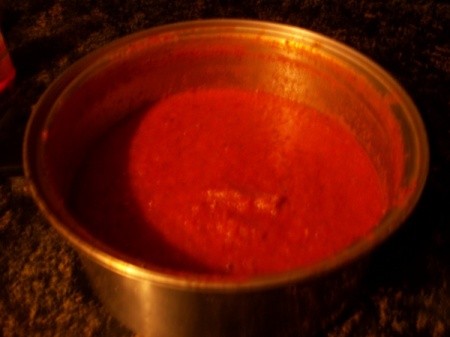Thaw tomatoes, puree in blender. Saute onion and garlic in olive oil until crisp tender. Using a large dutch oven saucepot, add tomatoes, seasonings and sauteed garlic and onions. Heat on medium to boiling, reduce heat to low, cover and simmer for at least 2-3 hours, stirring every 15-20 minutes. At this point, if thicker consistency is desired, remove lid and up heat to medium , stirring until more liquid is absorbed. The longer this simmers the better it is. When done you can either jar into quarts and process according to jar manufacturer directions, or let cool completely and ladle into quart freezer bags and freeze. Add hamburger or other meats to sauce before serving. Great on any pasta dish!
By Cheryl from Trinity, NC

Add your voice! Click below to comment. ThriftyFun is powered by your wisdom!
I grow most everything we eat during our summer months. Unfortunately, in Montana we do not have much of a growing season. With that said, with vegetables that do great, we grow plenty and then freeze them. Tomatoes are one of those items. However, I have never made pasta sauce from fresh tomatoes. I made sauce before but used canned tomatoes.
It always does my heart so much good to read posts from people like you, people who garden, and preserve the bounty, and cook homemade foods. Bless you.
One question... as I grow all of these herbs, wondering if the amounts are fresh or frozen? I have many bags of frozen tomatoes from last year and my plants are already giving me lots more, so I'm really excited about making this sauce!
Based on amounts, would say they are likely dried herbs. They are similar to another recipe I use and it called for dried herbs.
When converting from fresh herbs to dried, the rule of thumb is to divide by 3. So if a recipe calls for 1 Tbsp of fresh oregano, substitute 1 tsp of dried oregano.
I would think the same principle would work in reverse. To convert from dried to fresh, roughly multiply amount by 3. So 1 tsp dried basil equals 3 tsp or 1 Tbsp fresh basil. There may be some tweaking needed based on the form of the herb, but It's at least a place to start.
And, yum! Whether fresh or dried, nothing tastes as good as herbs and spices grown in the garden!
This looks great! What do you do with the tomato skin?
I run the tomatoes under hot water and the peel just slips off or you can use a hot water bath, again the peel slips right off. I usually try to remove blemishes and the stem end before freezing as they do not remove very well.
Throw skins into compost or leave out for half tame deer. They gobble it up
Last year, I scored the ends (an X) of our Roma tomatoes with a knife, then put them in galloon zip lock bags and into the freezer. Took them out today, put about 6 at a time into boiling water for about 20 seconds and then the skins just pop right off. Put all the frozen tomatoes in a big soup pot on low heat and when they were thawed out, I used an immersion blender to get them smooth.
Sun dry, then roast on barbecue.
I stuck my extra tomatoes in a gallon bucket and put them in the freezer at the end of the season last year. I don't know if the fact that I didn't vacuum seal them will ruin the sauce, any thoughts? I'm hoping to try to whip this up this weekend. How far in advanced should I get the tomatoes out? If they end up not working well, I'll let the chickens enjoy them!
I freeze my tomatoes on a cookie sheet then vacuum seal. I also just use an immersion blender in my pot, much less clean up and I dont mind a few pieces of tomato in my sauce.
Excited to make this tonight! We got frozen tomatoes from our garden last year #Eggzoited
Has this recipe been scientifically tested to know that it is safe for canning?
You would want to check the acid amount or add extra acid if you are water bath canning. If you are pressure canning, there is no concern about the acidity.
Here's some information that I copied from the link that follows:
"The USDA and University-based researchers have determined that to ensure a safe acid level for boiling water canning of whole, crushed, or juiced tomatoes, add 2 tablespoons of bottled lemon juice or ½ teaspoon of citric acid per quart of tomatoes. For pints, use 1 tablespoon of bottled lemon juice or ¼ teaspoon of citric acid. Acid can be added directly to the jars before filling the jars with product. Add sugar to offset acid taste, if desired. Four tablespoons of 5-percent-acidity vinegar per quart may be used instead of lemon juice or citric acid. However, vinegar may cause undesirable flavor changes."
nchfp.uga.edu/
Add your voice! Click below to comment. ThriftyFun is powered by your wisdom!